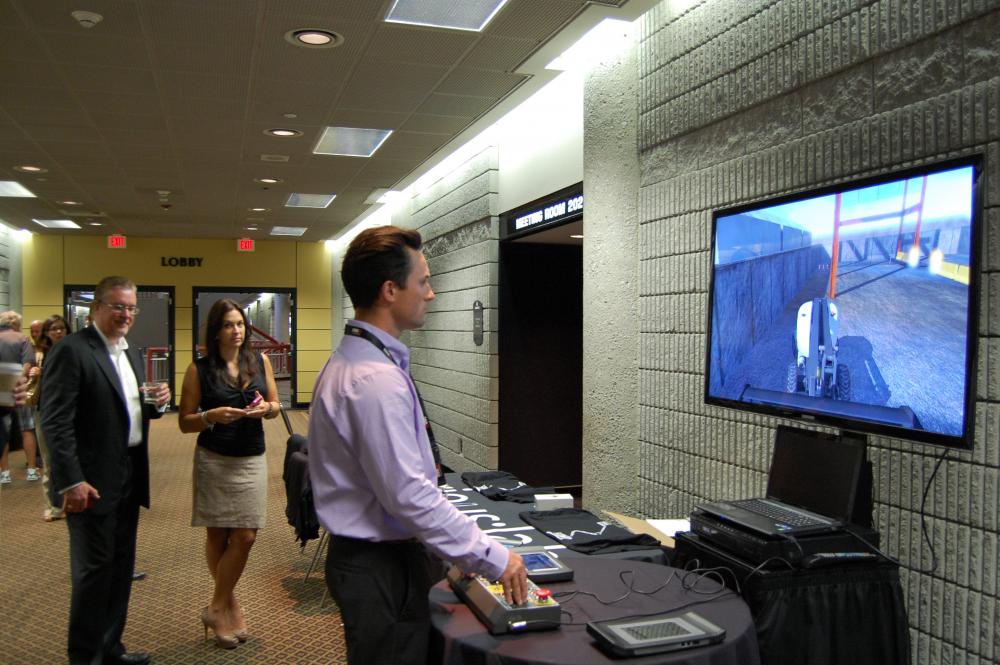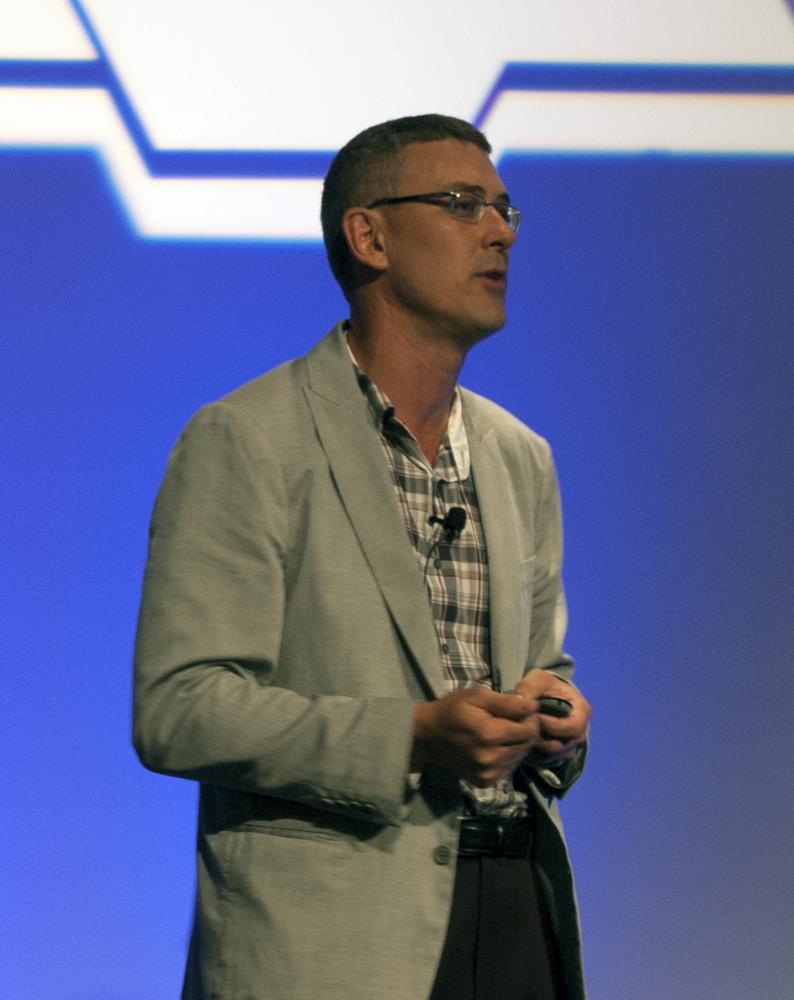




“It’s time to think differently,” said Jim Dorris, CSP, vice president of health, safety, environment & sustainability for United Rentals. Dorris kicked off last week’s Safe Access, Fall Protection & Training (SAF-T) Conference with a presentation on leading safety through innovation and technology. The event was held in conjunction with the Scaffold & Access Industry Association’s Annual Convention in Nashville. Sponsors of the event included Skyjack (Platinum); Genie, BlueSky Solutions, and United Rentals (Gold); Niftylift and Certified Training and Safety (Silver); JLG, IPAF, and MEC (Bronze); Aerial and Handling Services Ltd. (Coffee Break); and Serious: Labs (Lunch).
During his presentation, Dorris discussed how investing in technology and thought innovation contributes to a safer work environment. Key to this concept is focusing on why we do our jobs. Once that is recognized and becomes the focus, what we do and how we do our jobs will fall in place.
Dorris explained that understanding the evolving demographic of workers is critical to engagement. A good portion of today’s workforce has grown up on video games; therefore, engaging them means providing strong visuals along with hands-on training. Dorris said this type of engagement is key to developing a culture of early adaptors and innovators.
Innovation and technology comes in all forms, as evidenced in the number of other presentations that took place during SAF-T. In 2010, OSHA recorded 264 fall fatalities (255 were falls to a lower level) out of the 774 total fatalities in construction. This alarming figure calls for improving fall prevention techniques. To prevent falls from scaffolds and aerial lifts, Tiffany Hires, safety engineer and compliance officer for federal OSHA, explained the agency’s new fall prevention campaign. This nationwide outreach program will focus on ladders, scaffolds, and aerial lifts by providing a “simple steps” way to plan ahead to get the job done safely, provide the right equipment, and train everyone to use the equipment safely.
Planning includes deciding how the job will be done, what tasks will be involved, and what safety equipment may be needed to complete each task. Providing the right equipment is about protecting workers by providing fall protection and the right equipment for jobs that require workers who are at risk for serious injury or death if they should fall. Finally, falls can be prevented when workers understand proper setup and safe use of equipment, so they need training on the specific equipment they will use to complete the job. Employers must train workers in hazard recognition and in the care and safe use ladders, scaffolds, fall protection systems, and other equipment they'll be using on the job.
Roundtables of Ideas
At SAF-T, the first of two panel discussions that took place focused on online training and familiarization of equipment. Moderated by Kurt Southerland, CSP, manager, industrial safety—health, safety, environment & sustainability for United Rentals, the panel was asked questions by the audience on language barriers when training, training vs. familiarization of equipment, qualifications of trainers, telematics, and more. Panelists included Troy Gorostiza, president of Knowledge Stream; James “Red” Ronduen, corporate master trainer for United Rentals; Scott Owyen, training manager, global marketing for Genie; Tom Reed, safety direction of the Associated General Contractors of Tennessee; and Jeff Stachowiak, national safety training director for Sunbelt Rentals.
For many safety professionals, particularly with the advent of complementary online training options, improvements in the industry are seen as inspiring. “We’re coming into an exciting time right now,” Owyen said. “Increasing awareness is absolutely critical.”
Obstacles for contractors remain to be familiarizing operators on the machines, as well as overcoming language barriers. According to Gorostiza, “Technology today allows us to develop programs for different languages much more easily.”
Ronduen noted that training will take longer when providing training and familiarization to those who speak another language. “Having additional trainers on your team is crucial to training and breaking the language barrier,” said Ronduen. Manufacturers have adopted pictograms on machines to show hazards or operational tips, but these images vary from each manufacturer, opening up the question of conformity of controls and decals among OEMs.
Familiarization—a term defined in the ANSI A92 standards—tackles the topic of common controls and machine operations. “Familiarization is letting the operator know where controls are and the differences between the models,” Ronduen said. By comparison, he added that training is more in-depth and provided by a certified trainer.
“Lack of general training is the reason for 30 aerial lift accident a year,” Owyen said. “Typically what kills people on the job are hazards on the jobsite.”
With the variety of training for operators available, one question asked is what type of training is ideal? Stachowiak suggested looking for an evaluation and qualification procedure in a training program. “We have an opportunity to improve the process and set the standard,” he said. “It’s up to the employer and employee to determine training right now.”
This comment perfectly segued into the next panel discussion, which looked at general contractor’s jobsite expectations for access equipment suppliers. Panelists included Jeff Davis, EH&S manager for Kiewit Power Constructors; Ron Sears, safety director for Turner; Paul Settle, VP EH&S for Skanska; and Kenneth Coke, Regional SH&E manager for Parsons. The roundtable was moderated by Sunbelt’s Stachowiak.
Settle said that many general contractors look to see if an operator has a wallet card to show he or she has been trained, but many do not have a test to see if the operators are familiarized. “The benefit to us is to have standardized training in five years,” he added. Stachowiak suggested rental companies help vet subcontractors that have solid safety training records and trained operators, as well as recognize training providers who offer appropriate training that meets specific requirements.
When it comes to pre-start hazard inspections, all general contractors on the panel said they required a daily written inspection. “We have hazard assessments and pre-start inspections,” Davis said. “You have to coordinate with other people in your area. If things have changed, they need to be updated.” He added that inspections are important on a number of different levels. “If you aren’t doing inspections, your equipment breaks down quicker.” Coke added that they will often find damaged equipment when doing the pre-start inspection.
The panelists were asked what their one wish was for the access equipment and scaffold industry is. “Standardization of safety devices,” said Sears, while Davis added, “Guardrail systems and hand barricades to keep tools and material from going of the side.” Settle said his wish was to improve the professionalism of the end user so he understands the capacity of the machines and the safety features. Finally, Coke said telematics and more information on what the equipment is experiencing, including “how it is reacting to help us do our jobs better,” he added.
Safety from the Ground Up
Getting everyone involved in a company’s safety record was the focus of the next SAF-T Conference presentation. Mike Williamsen, Ph.D., CSP, senior safety consultant for Caterpillar Safety Services, presented on the topic of near-miss reporting and how it engages employees in the process by identifying and solving potentially injury-causing situations. “Develop a culture where it is your responsibility to address your issues—not OSHA,” said Williamsen. This includes overcoming the top 10 barriers to safety excellence, which are maintaining the status quo, an unclear definition of near miss, forms and paperwork, fear of punishment or retaliation, lack of recognition or feedback, desire to avoid work interruption, fault-finding mindset, concern for record/reputation, peer pressure, and red tape.
For a near-miss reporting program to work, supervisors must be as focused on safety as much as they are on productivity. With a solid program, “safety ends up driving your processes,” he said.
The SAF-T Conference concluded with a presentation made by Brad Boehler, president of Skyjack, who reviewed safe movement of equipment on the job. Throughout the presentation, he referenced the best practice documents developed for the access platform industry, including the Statement of Best Practices of Personal Fall Protection Systems for AWPT, Statement of Best Practices of General Training and Familiarization for AWP Equipment, and Statement of Best Practices of Workplace Risk Assessment and AWP Equipment Selection.
Last year, the International Powered Access Federation began collecting accident data from about 200 manufacturers, contractors, and rental companies. Boehler, who is an IPAF board member, said, “One year of data has led to some interesting questions already.” According to preliminary results, there were 31 fatalities worldwide involving elevated work platforms in 2012. The main causes of these fatalities were: fall from platform (9), electrocution (8), overturn (6), entrapment (4), and mechanical/technical related (4). Almost half of the number of reported fatalities (16) involved boom lifts. Eleven fatalities involved vehicle-mounted aerials, and four involved scissor lifts.
“We are a safe, reliable alternative to working at height,” Boehler said about access equipment. “Working at height is inherently dangerous. We are going to have accidents and incidents.”
Key to reducing accidents are eliminating, guarding, or warning against the risks found on the job. These include overhead obstructions; energized conductors/power lines/electrical hazards; other moving equipment or vehicles; obstructions during travel; overloading the platform; other personnel; unusual operating conditions like barges, ramps, or decks; debris; drop-offs; holes; slopes; bumps in floors or ground obstructions; wind and weather; improper AWP equipment solutions; and inadequate lighting.
“We need to tell operators to do a workplace assessment; it has to be done,” he said. “We need to tell people and train people on the hazards out there.”